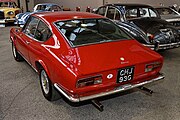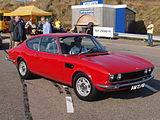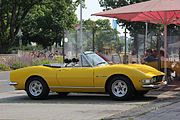Fiat Dino
| Fiat | |
|---|---|
|
Fiat Dino 2000 Spider (1966-1969)
|
|
| Dino | |
| Production period: | 1966-1972 |
| Class : | Sports car |
| Body versions : | Coupé , convertible |
| Engines: |
Petrol engines : 2.0–2.4 liters (118–132 kW) |
| Length: | 4107-4514 mm |
| Width: | 1709 mm |
| Height: | 1270-1318 mm |
| Wheelbase : | 2280-2550 mm |
| Empty weight : | 1170-1400 kg |
The Fiat Dino is a sports car that was presented by Fiat in the spring of 1966 on the occasion of the hundredth birthday of the company's founder Giovanni Agnelli . First, the Cabriolet called the Spider appeared, followed by the Coupé in the spring of 1967.
history
Dino is the short form of Alfredino, the diminutive of Alfredo, and was the nickname of Enzo Ferrari's son. Legend has it that Alfredo Ferrari is said to have whispered the data for the V6 engine in the ear of Ferrari employed Vittorio Jano , a proven and experienced racing engine designer , on his deathbed in 1956 . Jano is said to have designed this engine according to Alfredino's specifications, which was used from 1958 to 1960 in the 1.5-liter class of Formula 2 . After several rule changes in the individual racing classes, the unit was also found in other competitions and was used in variants with a displacement of up to 3.0 liters.
When the 1.6-liter class was introduced in 1966, the Dino engine returned to Formula 2. A production of at least 500 units was required for homologation. Since Ferrari was unable to produce such a number, Fiat took on this task. However, the original engine as a pure racing engine was not suitable for production in large numbers and numerous features were revised in order to make it more economical to manufacture and more suitable for everyday use. This task was taken over by the designer Aurelio Lampredi at Fiat . Among other things, Lampredi converted the engine block from aluminum to gray cast iron, drastically simplified the chain drive of the camshafts and introduced valve clearance adjustment with adjustment plates located on top of the bucket tappets instead of on the ends of the valve stems. Some of these changes (chain drive, valve clearance adjustment) were already introduced in the versions with the aluminum block, others only with the gray cast iron block.
Fiat also supplied the engines to Ferrari for the Dino 206 and Dino 246 GT . Ferrari always stated a higher performance than Fiat for its own engines. The main reason was the installation position of the Dino. There the engine was installed transversely in front of the rear axle. As a result, the exhaust system had to be redesigned. In addition, the Dino got two NACA air inlets on both sides at the back. While the right one is only used to ventilate the engine compartment, the left one is directly connected to the carburettors, which ensures a better air supply. In addition, other minor changes were made to the engine, so that Ferrari also allowed the use of the engines up to the maximum permitted engine speed (206 to 8000 rpm, 246 to 7600 rpm). All of these changes resulted in 20 more horsepower for the 2 liter engine and 15 horsepower for the 2.4 liter engine.
body
The car was produced in two body shapes: the Dino Coupé, designed by Bertone , and the open Dino Spider, designed by Pininfarina . The rounded Pininfarina superstructure was not available in a closed version. However, the designer Dany Brawand designed the Coupé 850 SS Sportiva for the Italian sports car manufacturer Moretti , whose lines were modeled on the open Dino.
Engines
The Fiat Dino was offered with the following engines:
- 01 / 1966–12 / 1968: Six-cylinder V-engine with aluminum block and 1988 cm³ displacement as well as three Weber carburetors, 118 kW (160 PS)
- 01 / 1969–12 / 1972: Six-cylinder V-engine with cast iron block and 2418 cm³ displacement as well as three Weber carburetors, 132 kW (180 PS)
Ferrari used the same engines in its mid-engined road vehicles sold under the Dino brand and manufactured from 1968 onwards. The larger engine was also used in the Lancia Stratos in the early 1970s , which won four world championships as a rally car .
Facelift
At the same time as the introduction of the 2.4-liter engine in the spring of 1969, the car was upgraded. Instead of a rigid axle on leaf springs, Fiat built in the independent rear suspension of the Fiat 130 with shock absorber struts and wishbones and changed the grille and rear lights.
production
In December 1972 production of the Dino ended. A total of 7651 copies were made.
| Technical data Fiat Dino | ||||
|---|---|---|---|---|
| Fiat Dino: | 2000 coupe | 2000 spider | 2400 coupe | 2400 spider |
| Engine: | 6-cylinder V-engine (four-stroke), fork angle 65 ° | |||
| Displacement: | 1987 cc | 2418 cc | ||
| Bore × stroke: | 86 × 57 mm | 92.5 × 60 mm | ||
| Performance at 1 / min: | 118 kW (160 PS) at 7200 |
132 kW (180 hp) at 6600 |
||
| Max. Torque at 1 / min: | 179 Nm at 6000 | 229 Nm at 4600 | ||
| Compression: | not specified | |||
| Mixture preparation: | 3 downdraft twin carburettors Weber 40 DCN14 |
3 Weber 40 DCNF downdraft register carburettors |
||
| Valve control: | 2 × 2 overhead camshafts, chain | |||
| Cooling: | Water cooling | |||
| Transmission: | 5-speed gearbox, stick shift, rear-wheel drive | |||
| Front suspension: | Upper wishbone, lower wishbone, coil springs | |||
| Rear suspension: | Rigid axle, semi-elliptical leaf springs, longitudinal thrust struts | Shock absorber struts, wishbones and wishbones, coil springs | ||
| Brakes: | Four-wheel disc brakes, diameter 27 / 25.4 cm | |||
| Steering: | Worm steering | |||
| Body: | Sheet steel, self-supporting | |||
| Track width front / rear: | 1380-1390 / 1350-1380 mm | |||
| Wheelbase: | 2550 mm | 2280 mm | 2550 mm | 2280 mm |
| Dimensions: | Coupé: 4514 × 1709 × 1318 mm Spider: 4107 × 1709 × 1270 mm |
|||
| Empty weight: | 1280 kg | 1170 kg | 1400 kg | 1240 kg |
| Top speed: | 210 km / h | 210 km / h | 205+ km / h | 210+ km / h |
| 0-100 km / h: | 9s | 8s | ||
| Consumption (liters / 100 kilometers): | 15.8 S | 15.2 p | ||
literature
- Automobil Revue , catalog numbers 1968 and 1971 (for technical data)
Web links
Individual evidence
- ^ Etienne Cornil: A Noble Thoroughbred Sports Car Graphic (March 1969) from Ferrari Dino 1965 1974 Limited Edition Extra, Brooklands Books, Cobham, ISBN 1-85520-578-5 , pp. 18-21.
- ^ Ferrari faces the future car (April 1969) from Ferrari Dino 1965 1974 Limited Edition Extra, Brooklands Books, Cobham, ISBN 1-85520-578-5 , pp. 22-24.
- ↑ Description of the Moretti 850 Sportiva (accessed on November 27, 2017).
- ↑ https://www.classicdriver.com/en/car/fiat/dino/1971/299944






